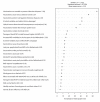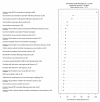Meningococcal W135 Disease Vaccination Intent, the Netherlands, 2018-2019
- PMID: 32568034
- PMCID: PMC7323551
- DOI: 10.3201/eid2607.191812
Meningococcal W135 Disease Vaccination Intent, the Netherlands, 2018-2019
Abstract
To control the rise in Neisseria meningitidis strain W infections, during 2018-2019, the Netherlands launched a catch-up meningococcal conjugate (MenACWY) vaccination campaign for teenagers (13-18 years of age). Applying a mental models approach, we surveyed teenagers and their parents about their knowledge and beliefs about meningococcal disease, the MenACWY vaccination, vaccinations in general, and their MenACWY vaccination intentions. Using random forest analysis, we studied predictions of vaccination intentions by knowledge and beliefs. Survey response rate was 52.8% among teenagers and 59.4% among parents. MenACWY vaccination intentions were best predicted by knowledge and beliefs about vaccinations in general, surpassing knowledge and beliefs about meningococcal disease and the MenACWY vaccination. For teenagers, their parents' intention that the teenager be vaccinated was a strong predictor of the teenagers' own vaccination intention. To optimize vaccination uptake during future outbreaks, we recommend that communications emphasize the effectiveness and safety of vaccines and continue to focus on parents.
Keywords: IMD; Neisseria meningitidis; W135; adolescent; attitude; bacteria; communication; disease outbreaks; health behavior; knowledge; meningococcal disease; mental models; parents; perception; teenager; the Netherlands; vaccination; vaccines.
Figures



Similar articles
-
Information needs during an emerging outbreak of meningococcal W135 disease in the Netherlands: a study among teenagers, their parents and healthcare professionals.BMC Public Health. 2021 Aug 12;21(1):1540. doi: 10.1186/s12889-021-11228-3. BMC Public Health. 2021. PMID: 34380443 Free PMC article.
-
Dynamics in public perceptions and media coverage during an ongoing outbreak of meningococcal W disease in the Netherlands.BMC Public Health. 2022 Apr 1;22(1):633. doi: 10.1186/s12889-022-12920-8. BMC Public Health. 2022. PMID: 35365114 Free PMC article.
-
Vaccine Impact and Effectiveness of Meningococcal Serogroup ACWY Conjugate Vaccine Implementation in the Netherlands: A Nationwide Surveillance Study.Clin Infect Dis. 2022 Jul 6;74(12):2173-2180. doi: 10.1093/cid/ciab791. Clin Infect Dis. 2022. PMID: 34525199 Free PMC article.
-
Evolving strategies for meningococcal vaccination in Europe: Overview and key determinants for current and future considerations.Pathog Glob Health. 2022 Mar;116(2):85-98. doi: 10.1080/20477724.2021.1972663. Epub 2021 Sep 27. Pathog Glob Health. 2022. PMID: 34569453 Free PMC article. Review.
-
Effectiveness of Meningococcal Vaccines at Reducing Invasive Meningococcal Disease and Pharyngeal Neisseria meningitidis Carriage: A Systematic Review and Meta-analysis.Clin Infect Dis. 2021 Aug 2;73(3):e609-e619. doi: 10.1093/cid/ciaa1733. Clin Infect Dis. 2021. PMID: 33212510
Cited by
-
COVID-19 Vaccination Intent and Belief that Vaccination Will End the Pandemic.Emerg Infect Dis. 2022 Aug;28(8):1642-1649. doi: 10.3201/eid2808.212556. Epub 2022 Jul 7. Emerg Infect Dis. 2022. PMID: 35797995 Free PMC article.
-
Differences in comprehending and acting on pandemic health risk information: a qualitative study using mental models.BMC Public Health. 2022 Jul 29;22(1):1440. doi: 10.1186/s12889-022-13853-y. BMC Public Health. 2022. PMID: 35902839 Free PMC article.
-
The Epidemiology of Invasive Meningococcal Disease in the Kingdom of Saudi Arabia: A Narrative Review with Updated Analysis.Infect Dis Ther. 2021 Dec;10(4):2035-2049. doi: 10.1007/s40121-021-00467-x. Epub 2021 Aug 14. Infect Dis Ther. 2021. PMID: 34390485 Free PMC article. Review.
-
Information needs during an emerging outbreak of meningococcal W135 disease in the Netherlands: a study among teenagers, their parents and healthcare professionals.BMC Public Health. 2021 Aug 12;21(1):1540. doi: 10.1186/s12889-021-11228-3. BMC Public Health. 2021. PMID: 34380443 Free PMC article.
-
Dynamics in public perceptions and media coverage during an ongoing outbreak of meningococcal W disease in the Netherlands.BMC Public Health. 2022 Apr 1;22(1):633. doi: 10.1186/s12889-022-12920-8. BMC Public Health. 2022. PMID: 35365114 Free PMC article.
References
-
- RIVM. Meningokokken [cited 2019 Dec 12]. https://www.rivm.nl/meningokokken
-
- Dubé E, Gagnon D, Hamel D, Belley S, Gagné H, Boulianne N, et al. Parents’ and adolescents’ willingness to be vaccinated against serogroup B meningococcal disease during a mass vaccination in Saguenay-Lac-St-Jean (Quebec). Can J Infect Dis Med Microbiol. 2015;26:163–7. 10.1155/2015/732464 - DOI - PMC - PubMed
Publication types
MeSH terms
Substances
LinkOut - more resources
Full Text Sources
Medical

